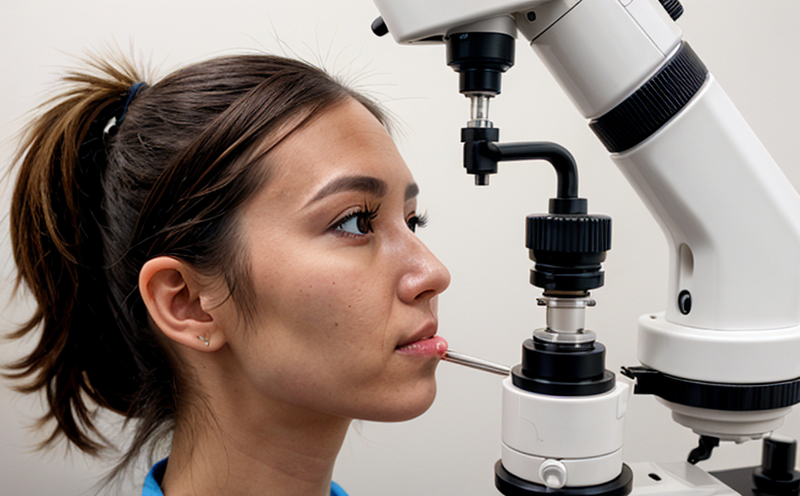ISO 11979-1 Intraocular Lenses General Requirements Testing
The ISO 11979 series of standards provides a comprehensive framework for ensuring that intraocular lenses (IOLs) meet the necessary quality and safety criteria. Specifically, ISO 11979-1 outlines general requirements for these devices, which are crucial in the medical device sector. This standard is particularly vital as it sets out the essential parameters that must be considered during design, development, manufacturing, and testing phases.
The primary focus of ISO 11979-1 is to ensure that IOLs are safe for use within the human body while maintaining their structural integrity and biocompatibility. Compliance with this standard helps manufacturers meet regulatory requirements and ensures product reliability. For quality managers, compliance officers, R&D engineers, and procurement specialists in the medical device sector, understanding these standards is paramount.
Testing under ISO 11979-1 involves a series of rigorous procedures aimed at evaluating various aspects of an IOL's design and performance. These include assessments related to biocompatibility, mechanical properties, optical performance, and overall sterility. The standard also emphasizes the importance of ensuring that any materials used in the construction of IOLs are suitable for long-term use within the human body.
One key aspect of ISO 11979-1 testing is the evaluation of the biocompatibility of the material used in the lens design. This involves assessing how the IOL interacts with the surrounding tissues and fluids without causing adverse reactions. Mechanical property tests are another critical component, ensuring that the materials can withstand the stresses placed upon them during use.
Optical performance testing is also an important part of this standard, as it ensures that the lens functions correctly under real-world conditions. This includes evaluating factors such as light transmission and aberration control to ensure optimal vision correction. Additionally, sterility tests are conducted to guarantee that the IOLs do not introduce any contaminants into the ocular environment.
The testing process typically begins with specimen preparation. This involves selecting representative samples of the IOL design according to ISO 11979-1 guidelines. After preparing these specimens, they undergo a series of mechanical tests designed to simulate real-world conditions and stresses. These may include compression, tensile strength, and impact resistance tests.
Biocompatibility testing follows this initial phase, where the IOLs are exposed to various biological fluids and tissues under controlled conditions. This helps determine whether the materials used in the lens could potentially cause adverse reactions or infections. Optical performance is then evaluated using specialized equipment that simulates light passing through the lens.
Finally, sterility testing ensures that all manufacturing processes have been carried out in a manner that prevents contamination of the IOLs. This includes assessing both the packaging and handling methods used during production to ensure they remain sterile until use by the patient.
The instrumentation required for this type of testing can vary widely depending on the specific tests being conducted. However, common equipment might include mechanical testers capable of applying controlled loads, optical analyzers designed for measuring light transmission properties, and biocompatibility chambers used for exposing samples to biological media.
Once all tests have been completed successfully, detailed reports are prepared documenting each step of the testing process along with results obtained. These reports serve not only as documentation but also provide valuable insights into potential areas where improvements can be made in future iterations of the design or manufacturing processes.
Benefits
Compliance with ISO 11979-1 offers numerous benefits to manufacturers and healthcare providers alike. For manufacturers, it provides a clear roadmap for ensuring that their products meet stringent quality standards before they reach marketplaces worldwide. This can enhance brand reputation by demonstrating commitment to safety and efficacy.
Healthcare providers benefit from knowing that devices comply with internationally recognized standards, which adds an extra layer of confidence when recommending or using these products. Patients ultimately gain peace of mind knowing their healthcare professionals are leveraging high-quality equipment.
In addition to enhancing product quality, adherence to ISO 11979-1 can also streamline regulatory processes by providing comprehensive documentation that aligns with global regulatory expectations. This reduces the likelihood of delays or rejections during approval stages.
Quality and Reliability Assurance
- Consistency in Testing: Ensures every batch produced adheres to strict quality standards.
- Enhanced Patient Safety: Guarantees that only reliable products make it into clinical practice.
- Compliance with Regulations: Helps manufacturers navigate complex regulatory landscapes confidently.
- Patient Confidence: Builds trust between healthcare providers and patients regarding the quality of treatments provided.
By adhering to ISO 11979-1, companies demonstrate their dedication to producing high-quality medical devices. This commitment translates into greater patient safety and satisfaction, which is crucial in any medical device manufacturing enterprise.
Environmental and Sustainability Contributions
The implementation of ISO 11979-1 contributes positively to both environmental sustainability and broader corporate social responsibility goals within the medical device industry. By ensuring that IOLs are designed, manufactured, and tested according to stringent quality standards, manufacturers reduce waste throughout their lifecycle.
Additionally, compliance with these international standards promotes more efficient use of resources during production processes. This includes optimizing material usage through precise design calculations based on ISO requirements. Moreover, adherence ensures proper disposal practices at end-of-life stages, minimizing environmental impact.
Manufacturers who prioritize sustainability align themselves with growing global trends towards eco-friendly business models. Such initiatives resonate well with consumers increasingly concerned about environmental issues and contribute positively to a company’s public image.





